|
City occurrence is closely connected with emancipating war of
the
Ukrainian people (1648-1654гг.) And reunion of Ukraine with Russia.
More three centuries ago, in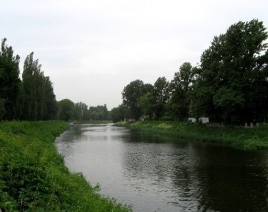 1654-1655, being rescued from oppression of the Polish sirs, on
territory of a present city which was a part of the Moscow state, the
big group of immigrants from Zadneprovia has come and has located on a
height, at merge of the rivers Lopani and
Kharkov (nowadays the University hill). Immigrants
have constructed here the dwellings and have enclosed with their paling.
This
settlement began to be called as Kharkov by name of the rivers on which
coast it has been constructed. The small river Kharkov name was known
to the basis of a city and for the first time it is mentioned in 1627.
Fortress building has soon begun. In 1656-1659 the first inhabitants of
settlement under the guidance of the representative of Russian
government in Kharkov - the commander Selifontova have constructed a
wooden fortress which was included into
system of the strengthenings intended for protection of the southern
Russian earths from
1654-1655, being rescued from oppression of the Polish sirs, on
territory of a present city which was a part of the Moscow state, the
big group of immigrants from Zadneprovia has come and has located on a
height, at merge of the rivers Lopani and
Kharkov (nowadays the University hill). Immigrants
have constructed here the dwellings and have enclosed with their paling.
This
settlement began to be called as Kharkov by name of the rivers on which
coast it has been constructed. The small river Kharkov name was known
to the basis of a city and for the first time it is mentioned in 1627.
Fortress building has soon begun. In 1656-1659 the first inhabitants of
settlement under the guidance of the representative of Russian
government in Kharkov - the commander Selifontova have constructed a
wooden fortress which was included into
system of the strengthenings intended for protection of the southern
Russian earths from 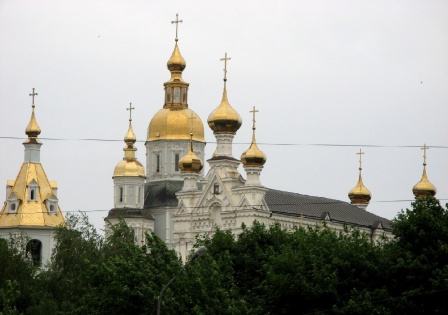 attacks
of the Crimean Tatars. Building of a fortress and
other defensive works protecting inhabitants from the predatory
attacks, in turn, promoted population increase. Every year the number
of immigrants arriving here grew, and soon, not having possibility to
take places within a fortress, they have started to lodge round
strengthenings. So in second half XVII centuries in Kharkov there were
first streets. To one of the first appeared streets of a city became
Moscow (now - the Moscow prospectus) on which the road to Moscow lay.
Have then appeared the Sumy street, along small river Kharkov - the
Belgorod road (now street Shevchenko), and in a southern part of a city
- Smieevsky (now - Gagarin's prospectus). From a fortress through Cold
Mountain the way to Poltava, and in the end of XVIII century - on
Ekaterinoslav lay, therefore this road-street long time was called as
Poltava, then
attacks
of the Crimean Tatars. Building of a fortress and
other defensive works protecting inhabitants from the predatory
attacks, in turn, promoted population increase. Every year the number
of immigrants arriving here grew, and soon, not having possibility to
take places within a fortress, they have started to lodge round
strengthenings. So in second half XVII centuries in Kharkov there were
first streets. To one of the first appeared streets of a city became
Moscow (now - the Moscow prospectus) on which the road to Moscow lay.
Have then appeared the Sumy street, along small river Kharkov - the
Belgorod road (now street Shevchenko), and in a southern part of a city
- Smieevsky (now - Gagarin's prospectus). From a fortress through Cold
Mountain the way to Poltava, and in the end of XVIII century - on
Ekaterinoslav lay, therefore this road-street long time was called as
Poltava, then
 Ekaterinoslavsky,
at
the USSR - street Sverdlova (the present name -
Poltava Shlah. In the end of XVII century round the Kharkov fortress
there were the settlements which have received the name
podgorodnimy by large villages. To the first of
them became - the Zalopansky large village. The steel following -
Zuravlevka, Panasovka, Goncharovka and others. In 1765 Kharkov became a
provincial city - the centre of
the Slobodsko-Ukrainian province, and since 1835 - the centre of the
Kharkov province. Considerable growth of Kharkov begins with 60 and
especially 80th years of XIX century when in connection with
cancellation of the serfdom and capitalism development to Russia
people, which were without the earth has been compelled to go for
earnings to a city. At this
time in Kharkov the first railway is laid, such factories, as the
Gelferih-garden (nowadays - "the Sickle and the Hammer"), Ekaterinoslavsky,
at
the USSR - street Sverdlova (the present name -
Poltava Shlah. In the end of XVII century round the Kharkov fortress
there were the settlements which have received the name
podgorodnimy by large villages. To the first of
them became - the Zalopansky large village. The steel following -
Zuravlevka, Panasovka, Goncharovka and others. In 1765 Kharkov became a
provincial city - the centre of
the Slobodsko-Ukrainian province, and since 1835 - the centre of the
Kharkov province. Considerable growth of Kharkov begins with 60 and
especially 80th years of XIX century when in connection with
cancellation of the serfdom and capitalism development to Russia
people, which were without the earth has been compelled to go for
earnings to a city. At this
time in Kharkov the first railway is laid, such factories, as the
Gelferih-garden (nowadays - "the Sickle and the Hammer"),
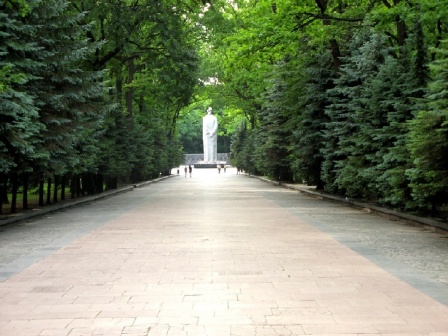 engine-building
(now factory of name Malisheva are under construction.
In the end of XIX century, with industry and
railway junction development, Kharkov becomes large industrial centre.
With a victory of the October socialist revolution and
formation of the Ukrainian Soviet Socialist Republic
with 1917 for 1934 with small breaks, Kharkov becomes capital USSR. At
this time there is a city rapid growth. New large factories are under
construction, develops machine-building and the metal-working industry,
develops a railway transportation. So, the mechanical engineering of
Kharkov in 1940 gave 40 % of production of all machine engineering
industry of Ukraine. The attack of fascist Germany in 1941 has
interrupted a creative life of a city. Having occupied a city, fascists
have established in it a mode of bloody terror and violence, have
ruined hundreds industrial enterprises. On August, 23rd, 1943 armies of
Steppe engine-building
(now factory of name Malisheva are under construction.
In the end of XIX century, with industry and
railway junction development, Kharkov becomes large industrial centre.
With a victory of the October socialist revolution and
formation of the Ukrainian Soviet Socialist Republic
with 1917 for 1934 with small breaks, Kharkov becomes capital USSR. At
this time there is a city rapid growth. New large factories are under
construction, develops machine-building and the metal-working industry,
develops a railway transportation. So, the mechanical engineering of
Kharkov in 1940 gave 40 % of production of all machine engineering
industry of Ukraine. The attack of fascist Germany in 1941 has
interrupted a creative life of a city. Having occupied a city, fascists
have established in it a mode of bloody terror and violence, have
ruined hundreds industrial enterprises. On August, 23rd, 1943 armies of
Steppe 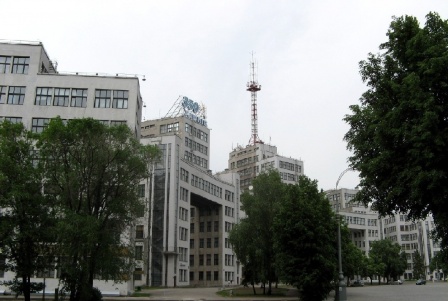 front
with active assistance of connections and parts of the
Voronezh and Southwest fronts have released Kharkov from fascist
aggressors. Has begun big and hard work on its restoration,
however
the city has been destroyed so,
that according to delegations of some the capitalist countries which
have visited Kharkov after its clearing, for city restoration it is
required nearby 50 years. However, contrary to these forecasts and
thanks to self-denying work of the population of a
city, in 1950 gross output release has exceeded pre-war level on 21 %,
and in 1956 -
in 4 times and Kharkov continued to develop. New large inhabited files -
Pavlovo Polie, Gagarin's prospectus, Saltovsky, Holodnogorsky,
Aleksieevsky, Rogansky and others have grown. The second in Ukraine
and sixth
in the USSR - the Kharkov
underground which
opening has taken place on
August, 23rd, 1975 became pride of inhabitants
and the line carries
front
with active assistance of connections and parts of the
Voronezh and Southwest fronts have released Kharkov from fascist
aggressors. Has begun big and hard work on its restoration,
however
the city has been destroyed so,
that according to delegations of some the capitalist countries which
have visited Kharkov after its clearing, for city restoration it is
required nearby 50 years. However, contrary to these forecasts and
thanks to self-denying work of the population of a
city, in 1950 gross output release has exceeded pre-war level on 21 %,
and in 1956 -
in 4 times and Kharkov continued to develop. New large inhabited files -
Pavlovo Polie, Gagarin's prospectus, Saltovsky, Holodnogorsky,
Aleksieevsky, Rogansky and others have grown. The second in Ukraine
and sixth
in the USSR - the Kharkov
underground which
opening has taken place on
August, 23rd, 1975 became pride of inhabitants
and the line carries
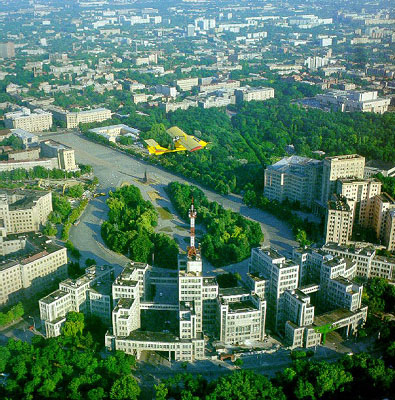 the
name Holodnogorsko-factory. The Saltovsky line of the underground
(it is opened on August, 10th, 1984)
became following,
and already the third line -
Aleksieevsky (is
opened on May, 06th, 1995) now is completed, that
will allow to connect much faster practically all large inhabited files
cities. The city becomes more beautiful and equips with
modern conveniences from year to year. On change to old suburbs modern
houses come. For today Kharkov totals 9 administrative areas:
Dzerzhinsky, Kievsky, Moscowsky, Chervonozavodsky, Octobersky, Kominternovsky,
Ordzhonikidzevsky, Leninsky and Frunzensky. First three are the largest and
occupied. However all areas are anyhow connected with various
historical events. Kharkov continues to grow and
develop... the
name Holodnogorsko-factory. The Saltovsky line of the underground
(it is opened on August, 10th, 1984)
became following,
and already the third line -
Aleksieevsky (is
opened on May, 06th, 1995) now is completed, that
will allow to connect much faster practically all large inhabited files
cities. The city becomes more beautiful and equips with
modern conveniences from year to year. On change to old suburbs modern
houses come. For today Kharkov totals 9 administrative areas:
Dzerzhinsky, Kievsky, Moscowsky, Chervonozavodsky, Octobersky, Kominternovsky,
Ordzhonikidzevsky, Leninsky and Frunzensky. First three are the largest and
occupied. However all areas are anyhow connected with various
historical events. Kharkov continues to grow and
develop...
|



